What is a Steer? Differences Between Steers and Other Bovines
Published: October 3, 2023
For those looking to brush up on their cattle knowledge, understanding what a steer is and how it differs from other bovines is key to a successful and efficient operation.
Whether you're just starting out or looking to expand your knowledge, read on to learn all about the differences between a steer and other types of cattle.
Cattle Terminology
Steer: A castrated male bovine before reaching sexual maturity.
Bull: A bull is a male bovine that has not been castrated and has reached sexual maturity.
Heifer: A heifer is a young female bovine that has not yet given birth to a calf.
Cow: A cow is a mature female bovine that has given birth to at least one calf.
Bovine: A bovine or “cattle beast” is a domesticated animal belonging to the Bovidae family, which includes cattle, bison, buffalo, and yak.
Calf: A calf is a young bovine less than one year old.
Male Cattle
There are two types of male cattle: a steer and a bull.
What is a Steer?

A steer is a castrated male bovine before reaching sexual maturity. A male calf is considered a “bull calf” or an “immature intact male bovine” since all males are born with male genitalia.
Once the bull calf is castrated, it’s considered a steer. They are castrated in the first few months of life.
Since they have been castrated, steers are typically raised for beef production. They are known for their impressive physical appearance (check out Knickers, one of the world’s largest steers), docile behavior, and usefulness in agriculture.
Physicality
Steers are generally larger and heavier than their female counterparts, cows, and have muscular bodies with broad shoulders.
Steers may have horns, which can vary in size depending on the breed (for example, Texas longhorns can grow spectacularly large horns). These may be removed to reduce the risk of injury.
Behavior
Since steers have been castrated and produce lower testosterone levels than bulls, they are generally docile and calm, making them easy to handle and work with. They may also exhibit playful behaviors such as running and jumping.
Purpose
The primary purpose of steers is for meat production, and they are raised for their high-quality beef, known for its rich flavor and tenderness.
What is a Bull?
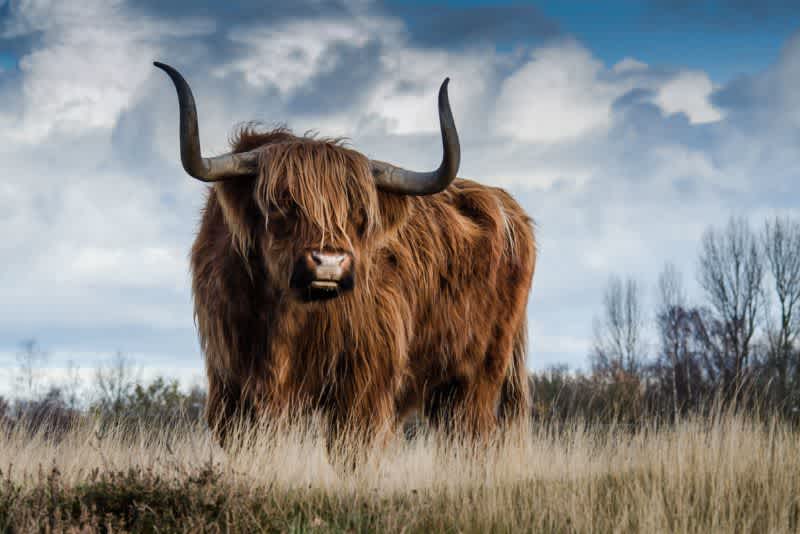
A bull is a male bovine that has not been castrated and has reached sexual maturity. Bulls are primarily used for breeding and bullfighting as opposed to meat production since their meat is more tough and gamey than other cattle types.
Bulls are known for their impressive physical appearance, unpredictable behavior, and entertainment in sports.
Physicality
Bulls are larger and more muscular than cows and steers. They have a large, robust body, broad shoulders, and muscular front and hind legs.
Many people believe only bulls have horns, which is not true. However, bulls and other cattle, such as cows, can have horns.
Lastly, a bull has a thicker hide than other cattle due to its high testosterone levels. Bulls can be of various colors, including black, brown, and white.
Behavior
Bulls can be unpredictable and aggressive, especially during the breeding season (from spring to early summer) or when they feel threatened. They have an instinct to protect their herd, sometimes resulting in aggressive behavior towards humans or other animals. However, they are also known to be playful at times.
Purpose
Bulls are primarily used for breeding or bullfighting, most notably in Spain. Bullfighting is a controversial sport due to concerns about animal cruelty, in which approximately 250,000 bulls die each year (that’s 35,000 in Spain alone).
Female Cattle
There are two types of female cattle: a heifer and a cow.
What is a Heifer?
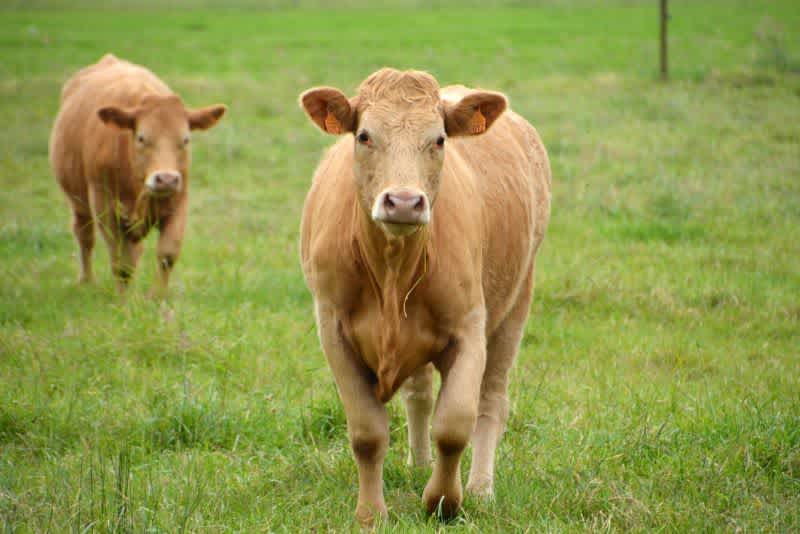
A heifer is a young female bovine that has not yet given birth to a calf. Heifers are small in stature and have potential as future breeding animals.
Physicality
Heifers are smaller than cows, bulls, and steers. Heifers have a smooth coat of short hair, which can range in color from brown to black to white. A heifer will have teats, while a cow will have a visible udder due to its milk production from giving birth.
Behavior
Heifers are generally docile and calm, especially when handled gently from a young age. They are social animals and tend to form herds with other cattle.
Purpose
Heifers are primarily used for breeding. They are raised to become future cows and produce milk or to be bred with bulls to produce offspring. However, heifers can also be used for meat production with high-quality characteristics.
What is a Cow?
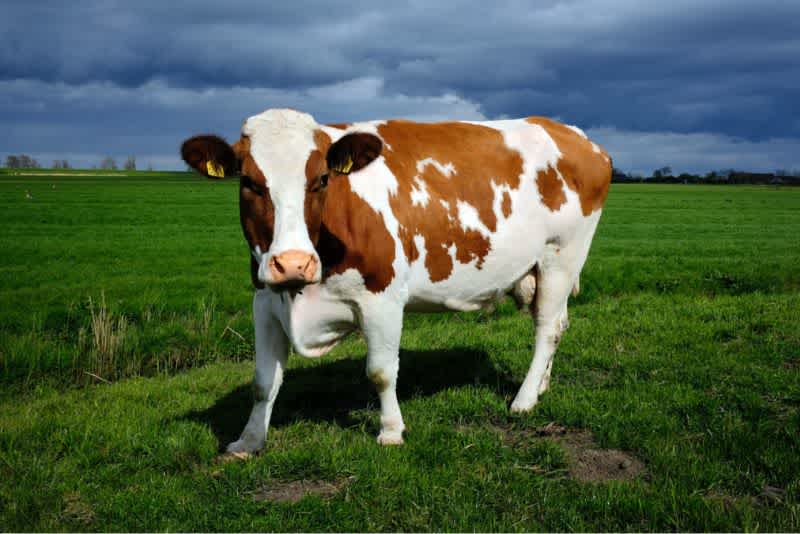
You might think that all cows are called “cows,” but that is not completely accurate!
A cow is a mature female bovine that has given birth to at least one calf. Cows are very maternal and are key in producing calves and dairy products.
Physicality
Cows are larger and heavier than heifers and have a more rounded and muscular body. They have a broad chest, large udder, and can have horns that vary in size and shape depending on the breed.
They typically have a smooth coat of short hair, which can be a range of colors, including black, brown, and white.
Behavior
Cows are instinctive to graze and can consume large quantities of grass and hay daily. Pregnant cows consume between 2-2.5% of their body weight, around 24 to 30 pounds of feed daily. They require more nutrients than other cows to keep up with fetal growth.
They also have a strong maternal instinct and will fiercely protect their calves from potential predators or threats.
Purpose
Cows are mostly used for milk and meat production. Dairy cows are explicitly raised for their milk, produced once the cow gives birth, and processed into a range of dairy products, including cheese, butter, and yogurt.
On the other hand, beef cows are raised for their high-quality meat, known for its rich flavor and tenderness.
What is a Bovine?
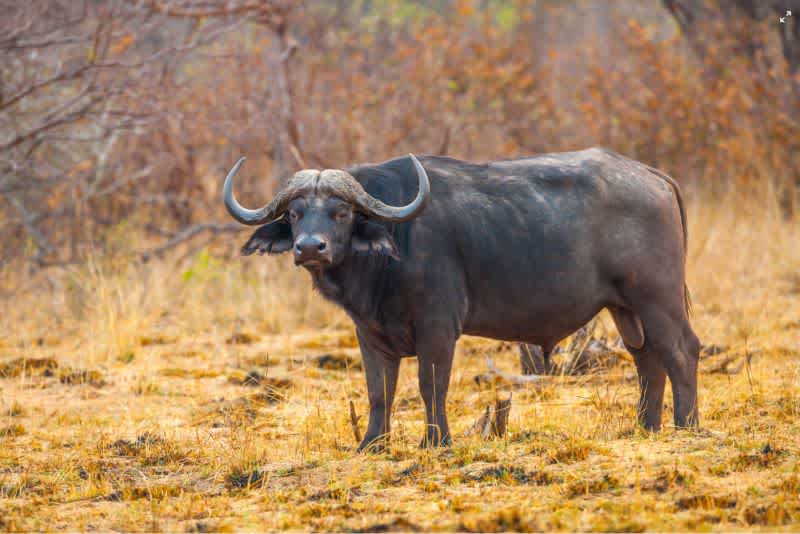
A bovine or “cattle beast” is a domesticated animal belonging to the Bovidae family, which includes cattle, bison, buffalo, and yak. They are known for their large size and muscular build.
Physicality
Bovines vary in appearance depending on the specific breed. However, they generally have a large, bulky body with four sturdy legs, a broad head, and, at times, horns or antlers. Their coat can be of various colors and textures, smooth or shaggy.
Behavior
Bovines tend to form herds or groups with other species members. They naturally graze and can consume large quantities of vegetation. Bovines are also known for their maternal behavior, with females protecting and nurturing their offspring.
Purpose
The primary purpose of bovines is for meat, milk, and labor. They are also used for their hides, which can be made into leather, and their horns, sometimes used as raw materials for various products.
Male vs. Female Bovines
Male and female bovines differ in their physical appearance and behavior.
Male bovines, known as bulls if uncastrated, are generally larger and heavier than females, with more muscular builds and more prominent horns. They are also more aggressive and territorial, especially during mating season.
Female bovines, or cows, are typically used for milk production or as breeding animals. They are known for their maternal behavior and can produce large quantities of milk for their offspring and human consumption. However, female bovines can also be raised for meat production.
Bovines are important domesticated mammals that are used for a variety of purposes in agriculture. Depending on the breed, they vary in appearance and behavior, and males and females have different roles and uses.
What is a Calf?

A calf is a young bovine that is less than one year old. They are known for their cute and playful behavior and are also important in agriculture.
Physicality
Calves are smaller and less muscular than adult bovines, with shorter legs and smaller stature. Their coat can be of various colors, including brown, black, and white. They are also born without horns, which typically grow soon after birth.
Behavior
Calves are curious and playful and like to explore their surroundings. They often run, jump around in open pastures, and play with other calves in their herd.
Heifer vs. Steer
The primary purpose of calves depends on their gender. There are two types of calves based on gender: steers and heifers.
A heifer calf is an immature female bovine, and they are typically raised for meat production or as breeding animals. Some female fetal calves with a male twin are “freemartin,” meaning they are an infertile or sterile heifers from exposure to male sex hormones while in utero.
On the other hand, a steer calf is an immature male bovine castrated before reaching sexual maturity. Before castration, steers are known as “bull calves.”
Steers are raised for meat production, are known to be less aggressive than bulls, and produce tasty meat.
Calves are important young bovines raised for different purposes depending on gender and are known for their playful behavior.
The Difference Between Dairy Cows and Beef Cows
Cattle have two distinct purposes: dairy or beef (although some cows can be used for both and are considered “dual-purpose.”)
Dairy Cows

A dairy cow is a type of bovine bred for milk production. Unlike beef cows, used for meat production, dairy cows are grown primarily for their milk for human consumption and the production of dairy products such as cheese, yogurt, and butter.
Physically, dairy cows are more thin and lean than beef cows, with a more angular body shape. They have less pronounced muscle and are generally longer than beef cattle. Dairy cows typically produce much more milk than beef cows, with beef cows only being able to provide enough milk for their calves.
One key difference between dairy cows and beef cows is their diet. Dairy cows are fed more of a grain-based diet designed to support milk production, whereas beef cows are often raised more on forage and grasses.
It's also worth noting that there is no such thing as "dairy bulls" because bulls are male and are not born with udders. They are primarily used for breeding.
There are many different breeds of dairy cows, each with unique characteristics and milk production capacity. Some common dairy cow breeds include:
Holstein: One of the most common dairy cow breeds, known for their high milk production and distinctive black and white coat.
Jersey: A smaller breed of dairy cow known for its rich, creamy milk and gentle temperament.
Guernsey: A medium-sized dairy cow breed known for its creamy, high-fat milk and distinctive brown and white coat.
Brown Swiss: A larger dairy cow breed is known for its docile temperament and high milk production (although not as much as Holstein).
Dairy cows are a specific type of bovine that are bred for their milk production and are different from beef cows, bred for meat production. Dairy cows have a specialized diet and physical appearance designed for efficient milk production.
Beef Cows
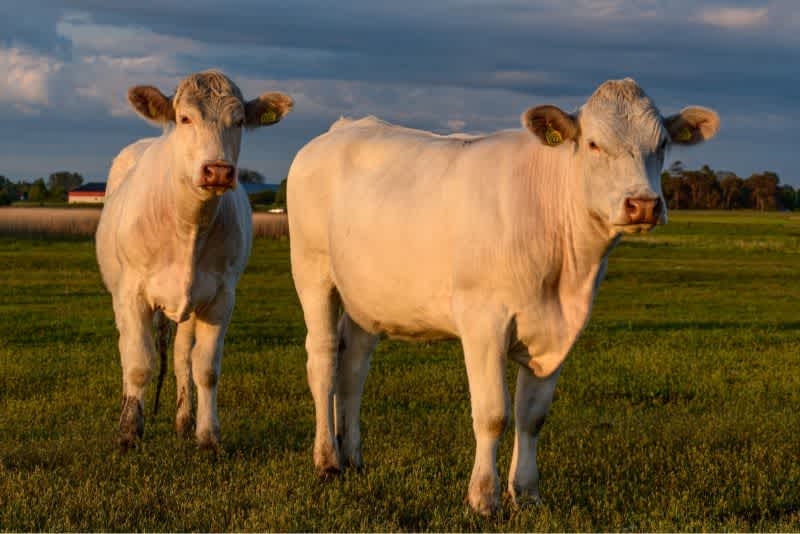
A beef cow is a type of bovine raised primarily for meat production, not milk production. While dairy cows are used for their high milk production and efficiency, beef cows are muscular and large, which makes them better suited for producing high-quality meat.
Beef cows are generally more muscular than dairy cows, with a shorter, stockier frame designed to support their weight and muscle mass. They have a different body composition, emphasizing muscle development rather than milk production.
Unlike dairy cows, bred to produce milk for several years, beef cows are often slaughtered at a younger age, usually around 36 months, when their meat is considered the highest quality.
There are many different breeds of beef cows, including hybrid beef cattle, each with unique characteristics and meat quality. Some common beef cow breeds include:
Angus: The most popular beef cow breed known for its marbled meat and excellent flavor. Angus cattle are typically black or red.
Hereford: Another popular beef cow breed known for its hardiness, adaptability, and productivity producing excellent beef. Hereford cattle are typically brown and white.
Charolais: A French breed of beef cow among the heaviest and fastest growing cattle breed. Charolais cattle are typically white or light-colored.
Limousin: A French breed of beef cow known for its quality lean meat and high yield. Limousin cattle are typically reddish-brown.
Beef cows are a specific type of bovine raised primarily for meat rather than milk production. They are physically different from dairy cows, with short and stockier body compositions and frames designed to support muscle development and weight gain.
Conclusion
Understanding the unique characteristics of a steer is crucial to the success of your beef production operation.
Remember that steers are always male that have been castrated, and because of this, they are typically raised for meat production. Their meat is generally tastier and more marbled due to lower testosterone levels, which can cause beef to be tougher and have a more undesirable gamey flavor.
By providing your steers with proper care, nutrition, and environment, you can ensure they reach their full potential and produce high-quality meat for people.
Whether you're just starting out in the cattle farming world or looking to expand your operation, always remember that the welfare of your animals should be your top priority!
Frequently Asked Questions
What is a steer vs. cow?
A steer is a male bovine castrated and raised for beef production, while a cow is a female bovine typically used for milk production and breeding.
What is a female steer?
There is no such thing as a female steer. A steer is a castrated male bovine, while a female bovine is either a heifer (immature female) or a cow (mature female).
Why do steers get bigger than bulls?
Bulls are usually bigger with more muscle than steers. However, some steers that live longer can grow larger than bulls due to hormone differences.
Keep track of all your cattle with the #1 Cattle Management Software
Try out Ranchr today for free